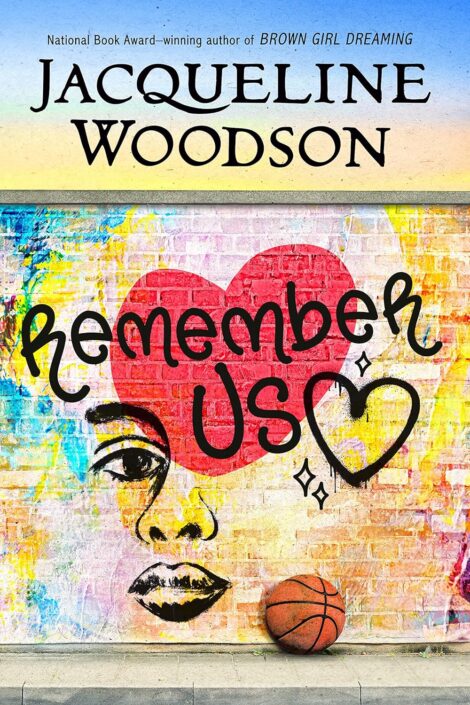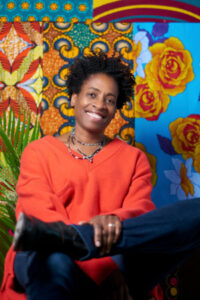
REMEMBER US
National Book Award winner Jacqueline Woodson brings readers a powerful story that delves deeply into life’s burning questions about time and memory and what we take with us into the future.
It seems like Sage’s whole world is on fire the summer before she starts seventh grade. As house after house burns down, her Bushwick neighborhood gets referred to as “The Matchbox” in the local newspaper. And while Sage prefers to spend her time shooting hoops with the guys, she’s also still trying to figure out her place inside the circle of girls she’s known since childhood. A group that each day,
National Book Award winner Jacqueline Woodson brings readers a powerful story that delves deeply into life’s burning questions about time and memory and what we take with us into the future.
It seems like Sage’s whole world is on fire the summer before she starts seventh grade. As house after house burns down, her Bushwick neighborhood gets referred to as “The Matchbox” in the local newspaper. And while Sage prefers to spend her time shooting hoops with the guys, she’s also still trying to figure out her place inside the circle of girls she’s known since childhood. A group that each day, feels further and further away from her. But it’s also the summer of Freddy, a new kid who truly gets Sage. Together, they reckon with the pain of missing the things that get left behind as time moves on, savor what’s good in the present, and buoy each other up in the face of destruction. And when the future comes, it is Sage’s memories of the past that show her the way forward. Remember Us speaks to the power of both letting go . . . and holding on.
- Nancy Paulsen Books
- Hardcover
- October 2023
- 192 Pages
- 9780399545467
About Jacqueline Woodson
 Jacqueline Woodson received a 2023 Guggenheim Foundation Fellowship, a 2020 MacArthur Fellowship, the 2020 Hans Christian Andersen Award, the 2018 Astrid Lindgren Memorial Award, and the 2018 Children’s Literature Legacy Award, and she was the 2018-2019 National Ambassador for Young People’s Literature. Her NY Times bestselling memoir, Brown Girl Dreaming, won the National Book Award, the Coretta Scott King Award, a Newbery Honor, and the NAACP Image Award. Her dozens of books for young readers include Coretta Scott King Award and NAACP Image Award winner Before the Ever After, NY Times bestsellers The Day You Begin and Harbor Me, Newbery Honor winners Feathers, Show Way, and After Tupac and D Foster, and Each Kindness, which won the Jane Addams Children’s Book Award.
Jacqueline Woodson received a 2023 Guggenheim Foundation Fellowship, a 2020 MacArthur Fellowship, the 2020 Hans Christian Andersen Award, the 2018 Astrid Lindgren Memorial Award, and the 2018 Children’s Literature Legacy Award, and she was the 2018-2019 National Ambassador for Young People’s Literature. Her NY Times bestselling memoir, Brown Girl Dreaming, won the National Book Award, the Coretta Scott King Award, a Newbery Honor, and the NAACP Image Award. Her dozens of books for young readers include Coretta Scott King Award and NAACP Image Award winner Before the Ever After, NY Times bestsellers The Day You Begin and Harbor Me, Newbery Honor winners Feathers, Show Way, and After Tupac and D Foster, and Each Kindness, which won the Jane Addams Children’s Book Award.
Praise
“An African American tween’s world is turned upside down by mysterious fires in her neighborhood and by self-doubt as she comes of age. . . . Drawing on her own experiences growing up in Brooklyn’s Bushwick neighborhood during the ’70s and ’80s, Woodson has crafted a beautifully lyrical narrative of change, healing, and growth. Her ability to evoke time and place is masterful; every word feels perfectly chosen. Sage is an irresistible character with a rich interior life, and her relationships with her mother and her friend Freddy are exceptionally well drawn. An exquisitely wrought story of self and community.” —Kirkus Reviews, starred review
“Another remarkable ode to Brooklyn and memory from the incomparable National Book Award winner. . . . Set during the 1970s, this nostalgia-tinged novel takes place when Bushwick was known as ‘The Matchbox’ because of the fires that plagued its streets. . . . The often wistful text is lyrical, but the nostalgia never overwhelms the narrative. Woodson’s economy of language expertly presents the microcosm of Sage’s community of friends and neighborhood kids and the macrocosm of the external world that threatens to destroy it. Sage’s journey to finding herself while trying to navigate these two worlds will resonate with readers young and old. The power of community and friendship permeates every word in this middle grade novel for all readers. A truly masterly work.” —School Library Journal, starred review
“This lyrical first-person upper middle-grade novel taps into a wide array of emotional truths and preteen sensibilities. Passages on loss and memory feature palpable sadness, but there is also a tender exploration of the enduring power of friendship and love, the discovery of inner strength and resilience, and the need to balance an appreciation for what ‘once was’ and what may be. Woodson again delivers an appealing protagonist whose voice will resonate with readers in a nuanced coming-of-age story worth remembering.” —Horn Book, starred review
“Woodson draws on her experiences growing up in Bushwick in the 1970s and ’80s to craft a nostalgic-feeling ode to the unexpected. Short chapters offer swift glimpses into momentous happenings in Sage’s life, while organic dialogue and mesmerizing prose lay bare a narrative that encourages learning to move with the ebbs and flows of life.” —Publishers Weekly, starred review
“The deeply moving novel from National Book Award winner Woodson is both elegant and accessible, and the novel-in-verse approach works wonderfully here, with occasional chapters consisting of only a few dramatic lines. Bushwick and its inhabitants are fully fleshed out with incredible detail and immense tenderness, and Sage immediately feels like a dear friend. A poignant portrayal of a historic neighborhood and an outstanding ode to the grief and gift of growing older. Woodson is one of the most esteemed figures in children’s publishing, and her historical fiction especially can’t be missed.” —Booklist, starred review
Excerpt
After the year of fire
vines rise up
through the rest of our lives
of smoke
of flame
of memory.
As if to say
We’re still here.
As if to say
Remember us.
1
The moon is bright tonight. And full. Hanging low above the house across the street where an orange curtain blows in and out of my neighbors’ window. Out and in. And past the curtain there’s the golden light of their living room lamps. Beyond that, there is the pulsing blue of their television screen. I see this all now. I see a world continuing.
And in the orange and gold and blue I’m reminded again of the year when sirens screamed through my old neighborhood and smoke always seemed to be billowing. Somewhere.
That year, from the moment we stepped out of our houses in the morning till late into the night, we heard the sirens. Down Knickerbocker. Up Madison. Across Cornelia. Both ways on Gates Avenue. Down Ridgewood Place. Rounding the corners of Putnam, Wilson, Evergreen . . .
Evergreen. Sometimes a word comes to you after time has passed. And it catches you off guard. Evergreen. The name of a family of trees. And the name of a block in Brooklyn. Evergreen. Another way of saying forever.
That year, nothing felt evergreen.
Palmetto. A word that has never left me. A word that in my mind is evergreen. Palmetto. The name for both a stunning tree and an oversize cockroach. Palmetto was also the name of a street in my old neighborhood. And that year, Palmetto Street was burning.
2
That was the year when, one by one, the buildings on Palmetto melted into a mass of rock and ash and crumbled plaster until just a few walls were left standing. Walls that we threw our balls against and chased each other around. And at the end of the day, when we were too tired to play anymore, they were the walls we simply sat down by and pressed our backs into, staring out over a block that was already, even as we stared at it with our lips slightly parted and our hands shielding the last of the sun from our eyes, almost gone.
We said Well, nothing lasts for always, right?
We said One day even the whole earth will disappear.
We were just some kids making believe we understood.
But we didn’t. Not yet.
We didn’t understand the fires. Or life. Or the world.
But we knew that neighborhood was our world.
And we knew . . . our world was burning.
3
That was the year of Freddy too.
4
Freddy moved into the corner building on Palmetto Street right where it was sliced through by a small block called Ridgewood Place. The brick houses on Ridgewood Place felt like they came from another time. Each house was just as perfect as the one beside it. The cars parked out in front of the houses were undented and shining. We didn’t understand how the people who lived on Ridgewood Place got such nice houses and fancy cars. But we understood why their brick houses remained standing long after the wooden houses of Palmetto Street had burned to the ground. So we slitted our eyes as we walked past the houses on Ridgewood Place, jealous because the kids who lived inside that brick didn’t have to worry about how quickly flames flew. And we slitted our eyes because we knew they didn’t have to sleep with their robes and shoes at the foot of their beds. We knew if those kids woke up in the middle of the night, it was only to go to the bathroom or climb into their parents’ bed during a thunderstorm.
5
Hey, girl!
The first time I ever talked to Freddy was the day he called to me from his window. I had been dribbling my basketball through my legs as I walked up the block but stopped to see who was yelling. It was summer, and the one tree on Palmetto Street was in front of his building. That’s what I remember now—looking up at Freddy through all that green.
Hey, yourself, I yelled back.
Where’s the park at?
What park?
My dad said there was a park around here somewhere. With hoops.
I shrugged. I don’t know anything about some park, I said.
But you got a ball.
So?
A hot wind came out of nowhere and trembled the leaves. I didn’t want to be yelling in the street up at some kid’s window, and something about that wind made me feel a way. So I gave a little wave and then broke into a jog toward the park.
